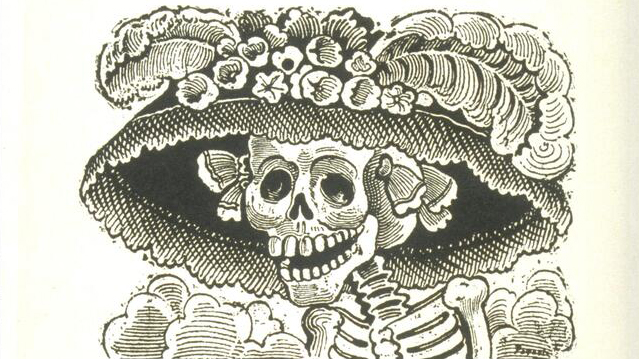Iconic Prints Celebrating Dia De Los Muertos On View This Fall At UMMA

José Guadalupe Posada, Calavera de la Catrina, circa 1910, relief etching on paper, Museum Purchase
Visitors to UMMA this fall will have a chance to see several prints from artist José Guadalupe Posada, whose depictions of calaveras or human skulls have had a lasting impact on Dia De Los Muertos celebrations around the world. The prints are on display as part of the Classical Film Theory installation of Curriculum / Collection at UMMA. Keep reading to see the works on view this fall and learn more about the holiday they have influenced and taken inspiration from.
José Guadalupe Posada (Mexico, 1852–1913),worked at a time when photography was first getting established. Posada worked for several publishers in Mexico City and images by him began appearing in publications around the late 1880s. Posada’s famed Day of the Dead images were based on social movements happening in Mexico at the time. Here's an artwork with a story revolving around the Mexican Celebration of Dia De los Muertos (Day of the Dead) and how Posada connects this cultural holiday to the Mexican Revolution he lived through.
Posada created La Catrina, a caricature of a person ashamed of their Indigenous ancestry and dressed to mimic a French upper-class style while wearing a lot of makeup to whiten their skin. La Catrina is now an iconic symbol for Dia De Los Muertos and has inspired many people to put on skull makeup and imitate her during the Mexican holiday.
Dia De Los Muertos is a holiday celebrated in México with indigenous origins from Aztec culture. It was adapted due to Christian influence and is now what we know today. Dia De Los Muertos translates to Day of the Dead in English. The event is split between two days, November 1st and 2nd. The first day is dedicated to the children who have passed, and the second day is for the adults. Rather than mourning the death of loved ones Mexicans choose to celebrate the lives they lived. It is said that the spirits of deceased loved ones come back from the land of the dead once a year to enjoy festivities and offerings. There are two ways to exchange these offerings and the most common is crafting an ofrenda, or visiting the graves and leaving the gifts behind.
Emiliano Zapata is an iconic leading figure in the Mexican Revolution and champion of the rural poor. Zapata was a mestizo peasant who was orphaned and was left with the responsibility of taking care of his brothers and sisters. He led his community in protests against the hacienda (plantations and/or mines set up by the government) that led them in taking the land by force from Mexican President Porfirio Díaz. Zapata is depicted as a skeleton because skulls are usually symbols used on an Ofrenda.
An ofrenda is traditionally split into three tiers. The top tier identifies the dead being invited to the altar with photos of those who have passed, along with religious symbols of La Virgin De Guadalupe (also known as Mary, the mother of Jesus) and crucifixes. The second tier invites the dead into the home with offerings of food and any other objects for them to enjoy and take back with them to the land of the dead. One of the desserts traditionally offered is pan de muerto (or Bread of the Dead), a traditional semi-sweet bread that is baked and dusted with sugar to represent the soil that the bodies are buried in. The third tier is often decorated with candles, marigolds (an orange Aztec flower also known as cempazúchitl), and sugar skulls.
This calavera's facial hair resembles Francisco Madero, the president of Mexico (1911-1913) who promised Emiliano Zapata he would return the land back to the indigenous people. Zapata organized a small force to help Madero unseat the current president at the time, Díaz. After they succeeded Zapata was upset with the pace of land reform under the new president Madero, so he led a small group of everyday civilians to campaign and took the land back from the haciendas and returned it to the native people called ejidos. Victoriano Huerta joined forces with the rebels, compelled Madero to resign, and assumed the presidency himself. Madero was shot a few days later on Huerta’s orders.
Overall, Dia De Los Muertos is a very cherished holiday in Mexico. Not everyone celebrates the same way and there are added traditions families partake in. Anyone is more than welcome to take the day to gather with family and remember loved ones.
This artwork is named for Victoriano HuertaBorn of indigenous parents, an indigenous person who rose to the rank of general in the army during the rule of Díaz. The artwork was named after Huerta, a general who helped overthrow Diaz. Huerta served his successor, president Francisco Madero, as chief of staff of the army.
Don’t miss your chance to see these incredible prints this Fall at UMMA!
Curriculum / Collection
Explore the infinite value of art in shaping our understanding of...well, everything
View Exhibition
